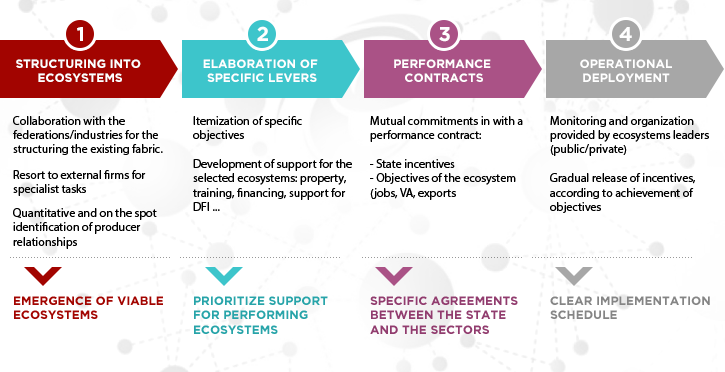The Ecosystems
The industrial ecosystems

Concept and implementation
The Industrial Acceleration Plan 2014-2020 introduced a new approach based on the establishment of industrial ecosystems. This flagship element of the new industrial strategy aims at reducing fragmentation of the sector by fostering the development of targeted and mutually beneficial strategic partnerships between industry leaders and Very Small, Small and Medium Enterprises (Très Petites, Petites et Moyennes Entreprises – TPME).
More precisely it is a question of uniting business groups around companies driving ecosystems projects. These drivers may be national industry leaders, professional groups or foreign investors.
Alliances of companies develop and form organized “communities of strategic destiny” involving sector leaders and increase their performance and responsiveness, hence strengthening the competitiveness of entire industries.
Such ecosystems, forming a new type of collaboration, enable the industry to be a major supplier of jobs, especially for young people, and thus become part of a virtuous circle of progress.
The process for setting up the ecosystems comes in four steps:

Work progress
The construction of the ecosystems is taking place at a significant rate. The approach has benefited immediately from the commitment of national operators who have promptly accepted the logic of ecosystems.
The structuring of sectors that was carried out during recent months, in partnership with professionals, has enabled the identification of those for which it is appropriate to establish ecosystems.
This work has resulted in the launch of 7 ecosystems in the automotive industry, 6 in textiles, 5 in aeronautics, 1 in heavy goods vehicles and industrial bodywork, 6 in building materials industries, 3 in mechanical and metallurgical industries, 2 in the chemical industry, 3 in the leather sector, 5 in Offshoring, 2 in pharmaceutical industry, 7 in agri-food sector and one OCP ecosystem.
Specific targets are set for companies within ecosystems, as part of performance contracts agreed between the holders of ecosystem projects and the state, especially in terms of job creation, added value, and export capacity. In return, the state undertakes to provide appropriate and specific support for each activity particularly in terms of availability of land, training of human resources and supply of funding.

